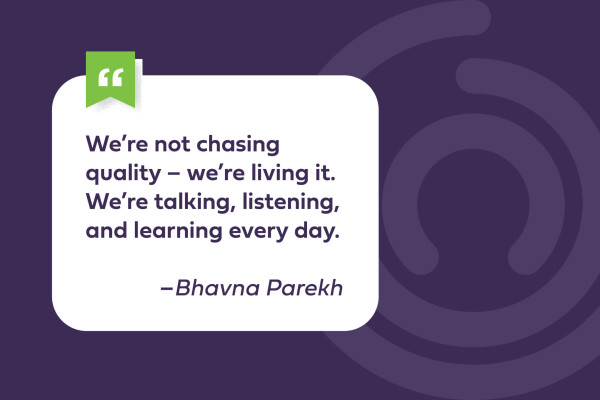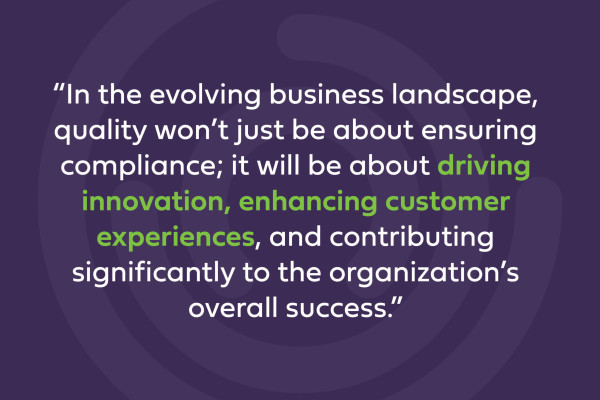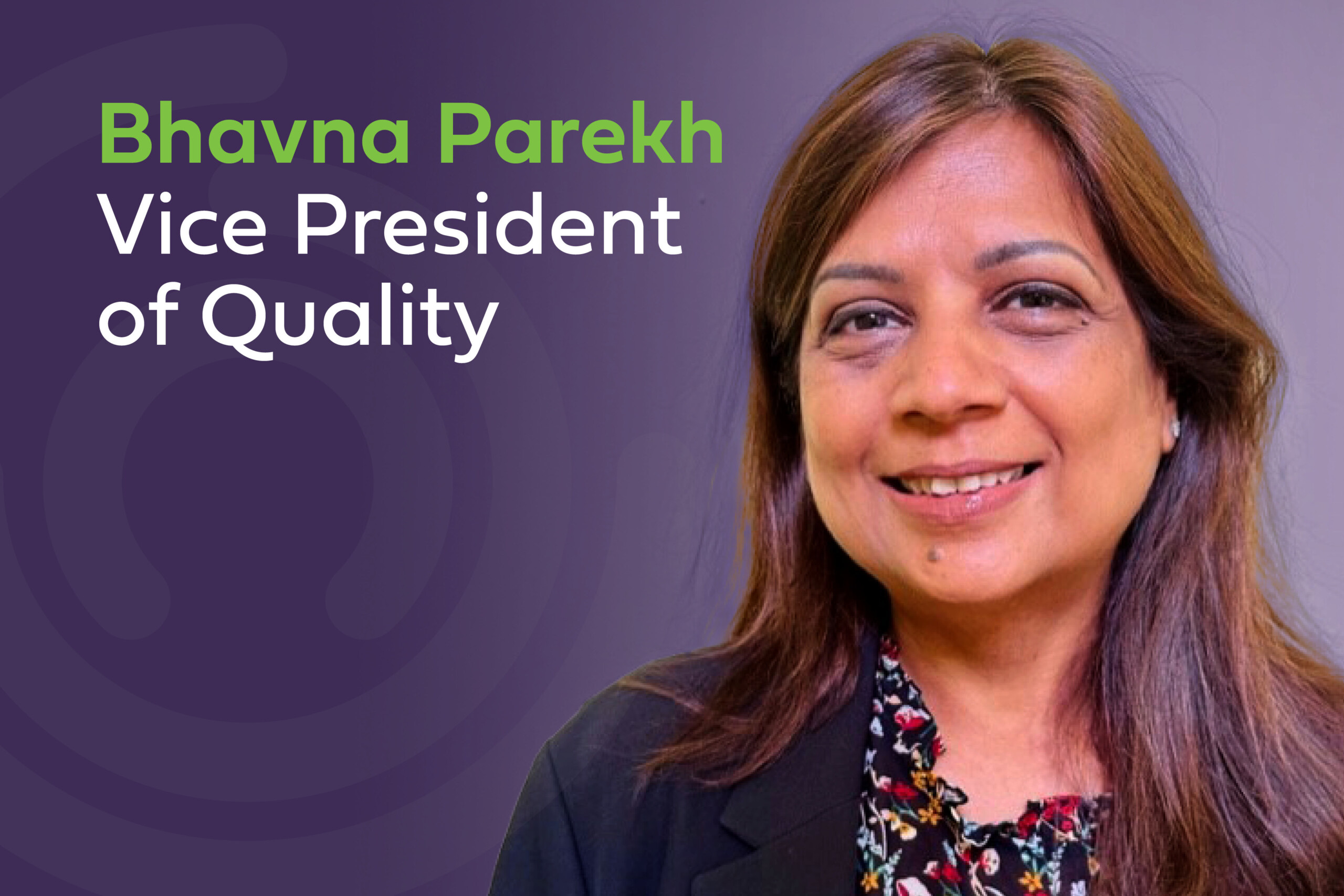- News
- Unlocking the Competitive Potential of Quality with…
News
Unlocking the Competitive Potential of Quality with BioTouch’s Bhavna Parekh
In today’s world, quality is more than just a goal; it is a critical strategic initiative. Businesses must meet and exceed requirements, guaranteeing their products and services are not only great but also unparalleled. To celebrate Quality Week 2023 (themed “Quality: realizing your competitive potential”), we sat down with seasoned expert, Bhavna Parekh, who stands at the forefront of quality management as VP of Quality for BioTouch globally.
With over 25 years of experience in operations, quality, and compliance, Bhavna has a deep understanding of the intricate balance between innovation, customer satisfaction, and organizational efficiency, shedding light on the essential role quality plays in today’s competitive landscape.

Quality: Realizing Your Competitive Potential
The theme for World Quality Week 2023 is “Quality: realizing your competitive potential.” How do you interpret this theme and what significance does it hold for businesses and organizations?
The theme really hits home for me. In our industry, we’re not just competing; we’re navigating a landscape dictated by strict regulations. Quality isn’t a checkbox for us; it’s our way of life and our competitive edge. Our customers are demanding more and we need to meet their expectations. They want everything to be transparent and efficient, from documentation to tracking to metrics. They expect us to be proactive, spotting issues before they even notice.
But what’s interesting is that this emphasis on quality isn’t just a necessity. It’s the key to our competitive edge and what sets us apart. When we talk to potential clients, we can confidently say, “Yes, we have fantastic products, but let me show you our processes and controls.” We can show we have everything in place to ensure the service provided is not just what you expect, it’s better. From packaging to labeling, our products and solutions are tailored exactly to your needs. It’s about meeting expectations and exceeding them every single time. Quality is not negotiable and it’s not a tagline. It’s how we do business.
Understanding Your Customers
How does your organization gather and analyze customer feedback, complaints, and preferences to develop products and services that align with customer needs and expectations?
Diving into our customers’ world has always been a game-changer for us. Understanding our customers isn’t an exercise in ticking off boxes; it’s about truly grasping what they need before realizing it. Of course, we cannot catch every issue the first time around. That’s where our secret weapon comes in – how we gather and analyze feedback and complaints.
We’re all about conversations. We talk to our customers regularly, listening closely to their pain points, formal complaints, and other feedback. Sometimes, it’s about tiny tweaks like font sizes on labels. To us, these details matter. So, we regularly meet with our R&D and Product Development partners, brainstorming ways to make things even better. It’s about being proactive.

Can you share specific quality tools, methodologies, or tips & tricks your team employs, such as customer surveys or statistical analysis, to understand customer requirements better?
We’re all eyes on the data, too. We’re harnessing tools like Tableau and Power BI, dissecting historical data to spot trends and anticipate issues before they even arise. We make informed decisions based on data, staying ahead of the curve.
Collaboration is also crucial. We’re ensuring that every person across our global BioTouch family is on the same page and is a quality champion, not just the quality team.
In my previous roles, I have encouraged different teams to spend a day with our customer service team, hearing the frustration in customers’ voices firsthand. It may be more than a label mistake or the wrong size tube; it could be a patient’s day disrupted. Seeing that impact makes us laser-focused on every detail, every piece of feedback. Our customers are people, not stats.
So, in a nutshell, we’re not chasing quality – we’re living it. We’re talking, listening, and learning every day.
Developing a Culture of Quality
How important is employee involvement in maintaining a culture of quality within an organization?
Employee involvement is critical. We want our team to know they’re vital contributors to our quality mission.

What types of training and development programs do you recommend for employees to enhance their quality-related skills?
First, it’s about visibility and accessibility. We’re making sure our employees know who to reach out to when they encounter a problem or have a brilliant idea for process improvement. After all, they’re the ones on the manufacturing floor, and they understand what’s working and what’s not.
We’re encouraging them to come forward with their suggestions and insights. We can’t tackle every issue at once, but we can prioritize based on the potential impact. We’re taking a risk-based approach to assess opportunities, and we’re closely collaborating with our operations team. We also make sure to provide feedback to the employees who suggest the idea so they are in the loop with insights into its status and the reasons behind it.
What are some of the key quality initiatives and strategies your organization has implemented to ensure that every team member understands the significance of delivering high-quality products and services? Are there specific quality metrics and goals in place?
Fostering a quality mindset is all part of a cultural shift, a move towards understanding that quality is non-negotiable. It’s about making quality everyone’s responsibility, not just the quality departments. However, the leadership team and quality are setting the example, making sure our behavior reflects what we expect from our team. It’s a simple yet effective approach that’s already bringing about positive change.
Ultimately, we’re fostering a culture of quality through employee involvement, training and development programs, continuous improvement, and a commitment to making data-driven decisions. We’re setting the example and inspiring our team to be champions of quality.

Differentiating Your Products and Services
In what ways does BioTouch differentiate its products and services from competitors, based on the unique features or benefits identified through your understanding of customer needs?
When customers see BioTouch, they’re not just seeing a company; they’re witnessing a team dedicated to continuous improvement, a team that values collaboration, and a team that’s shaping a future where excellence is not just a goal, but a habit.
It’s a collective journey wherein every team member’s involvement is crucial and propels BioTouch to the next level.
Could you provide examples of how quality tools, such as benchmarking or value analysis, have helped you identify areas for differentiation and improvement in BioTouch or previous roles?
One significant step we’re taking to differentiate ourselves in the market is the GlobalLink project, where we are creating one global medical kitting platform for all of our customers. It’s not merely a globalization process plan; it’s a leap toward automation. While it might not seem like a distinct differentiation, the impact it will have on our services and customer satisfaction is huge.
By streamlining our processes and reducing manual errors, we’re enhancing our efficiency. This translates into fewer mistakes, a decrease in complaint rates, and, most importantly, more time and resources to invest back into refining our services for the future.

Continuously Improving Your Processes
Maintaining a competitive advantage requires continuous process improvement. How does your organization encourage employees to identify problems and suggest process enhancements?
We involve our employees and give them the chance to make a real impact. We encourage them to address problems, share ideas, and suggest enhancements to make our processes better together.
We’re also focusing on personal and professional growth opportunities. We’re offering opportunities for employees to develop their skills, providing them with the chance to work across departments, and fostering diversity within the organization. It’s not about confining talent to one area; it’s about cross-pollination and learning from different corners of the company. It’s about creating an environment where feedback is not only valued, but also actively sought after.
Can you share specific instances where quality methodologies like Six Sigma or Lean have been instrumental in streamlining processes and ensuring the efficient delivery of high-quality products and services?
Looking back at my experience, especially at Johnson & Johnson, we were deeply invested in methodologies like Six Sigma and Lean. These weren’t just buzzwords; they were transformative tools. For example, Lean principles were instrumental in streamlining our processes. In our labs, we mapped out workflows meticulously and observed how much time it took for an employee to complete a task. We realized that the physical layout was hindering efficiency. So we restructured the space, creating cells that had everything an employee needed within arm’s reach. This not only made tasks quicker but also reduced the chances of mix-ups, enhancing the overall quality of our work. This is a perfect example of how continuous improvement makes life easier for our employees while also benefiting the business.
These experiences have shaped my approach at BioTouch. We’re integrating these methodologies into our processes. We’re training our team members and also educating them about the why and the how. If we empower our employees with the right tools and opportunities and foster a collaborative environment, we will naturally create a culture of continuous improvement.

Embracing Innovation
Are there specific quality tools, such as Design Thinking or FMEA, that your organization utilizes to manage risks associated with innovative ideas and ensure the quality of new products or services?
BioTouch embraces innovation to enhance quality. We employ versatile tools like Design Thinking and FMEA to carefully manage risks tied to innovative concepts. These tools allow us to explore ideas thoroughly, ensuring that the quality of our products and services remains top-notch.
For example, we’re in the process of transitioning to an electronic quality management system (eQMS) that will streamline our processes, ensuring consistency and reducing complexities. We’re currently using FMEA to refine this process globally, leveraging the expertise across different sites. It aligns with our goal of a seamless global quality management approach, so what’s visible in Georgia is also visible in Shannon, Ireland.
Looking ahead, what do you believe will be the key focus areas for quality management in the coming years, and how can organizations prepare for these changes? How do you envision the role of quality management evolving in the future business landscape?
In the evolving business landscape, quality won’t just be about ensuring compliance; it will be about driving innovation, enhancing customer experiences, and contributing significantly to the organization’s overall success.
Quality management will be the backbone of businesses, ensuring organizations thrive in the ever-changing market. But quality isn’t just a departmental function; it’s everyone’s responsibility.
Quality Solutions From Your Healthcare Logistics Partner
BioTouch is a single-source, international provider that brings a higher level of care to healthcare delivery, spanning medical kit and supply distribution, printing, logistics, temperature-control, and last-mile services.
Our solutions help eliminate silos and give laboratories and hospitals all the critical intelligence needed to create new efficiencies across the entire organization, allowing you to focus on what you do best: patient care.
